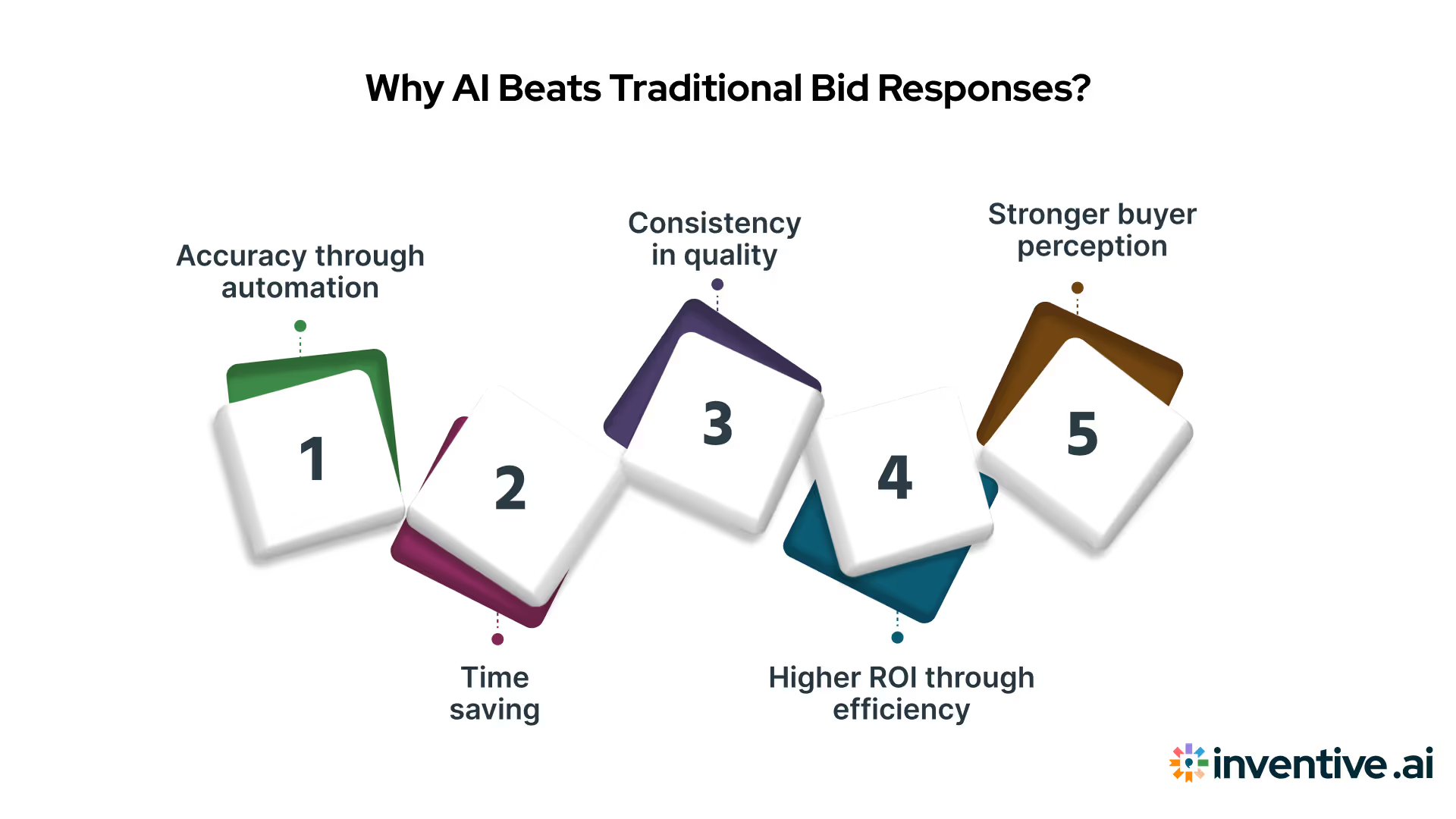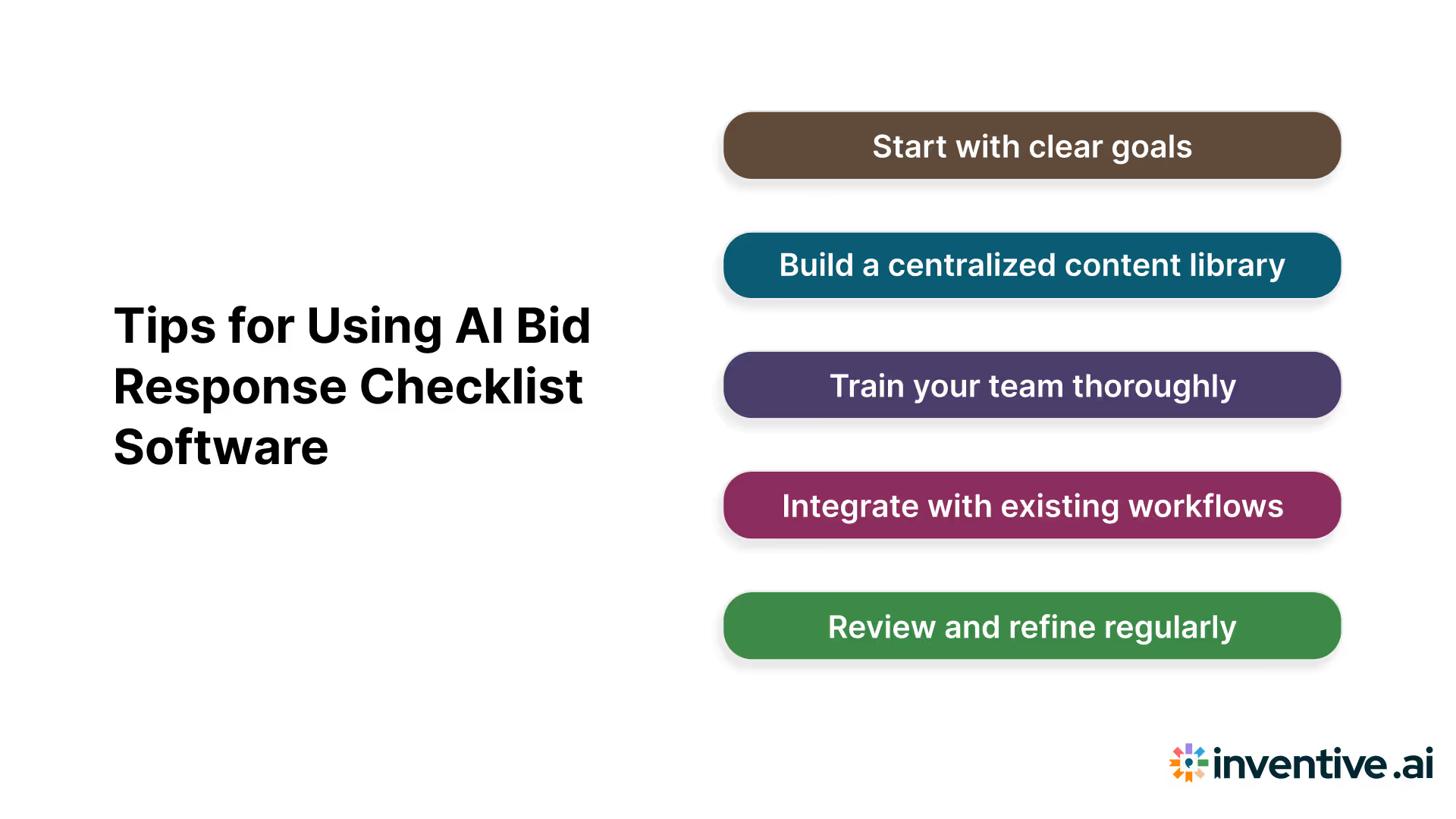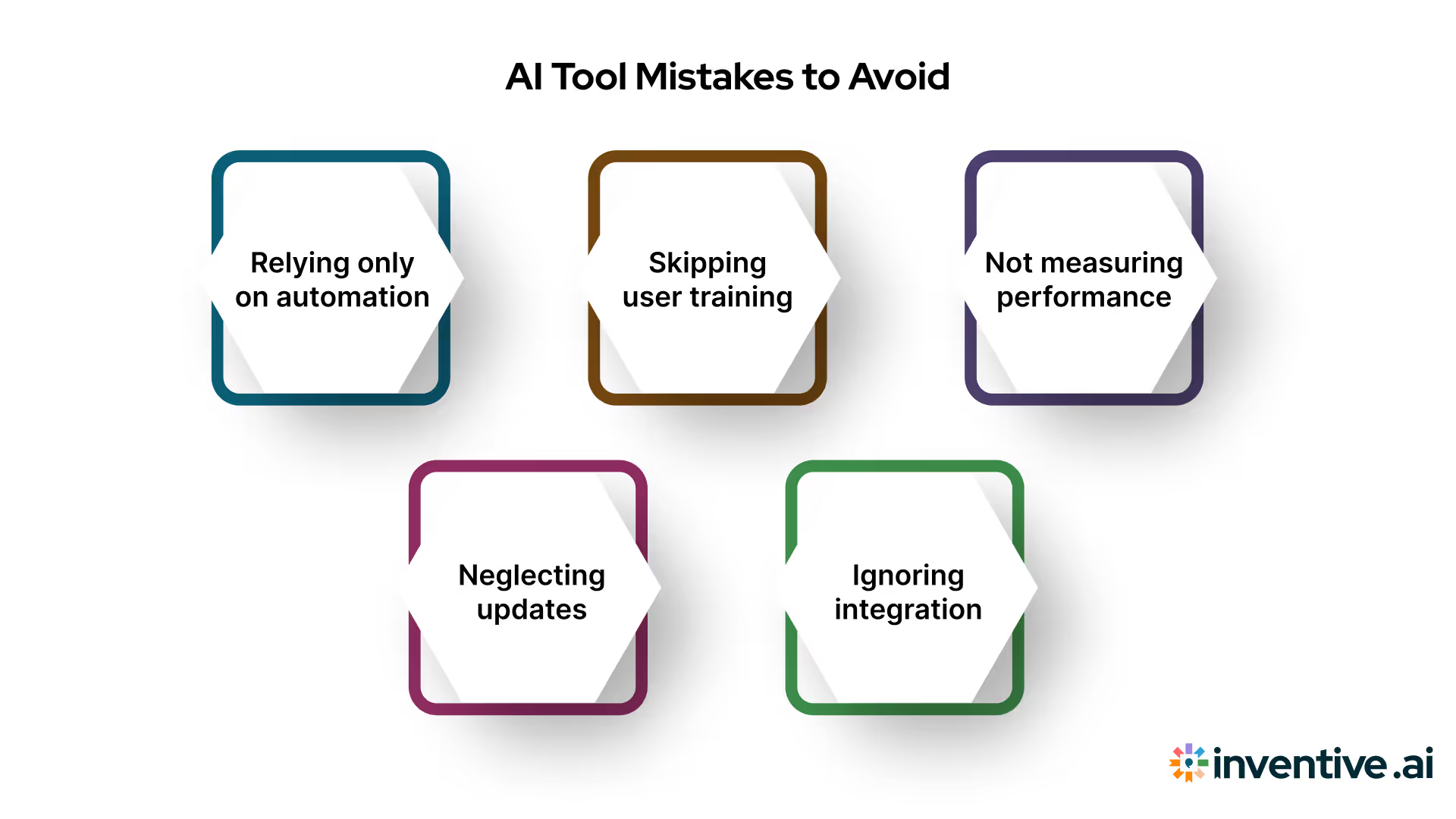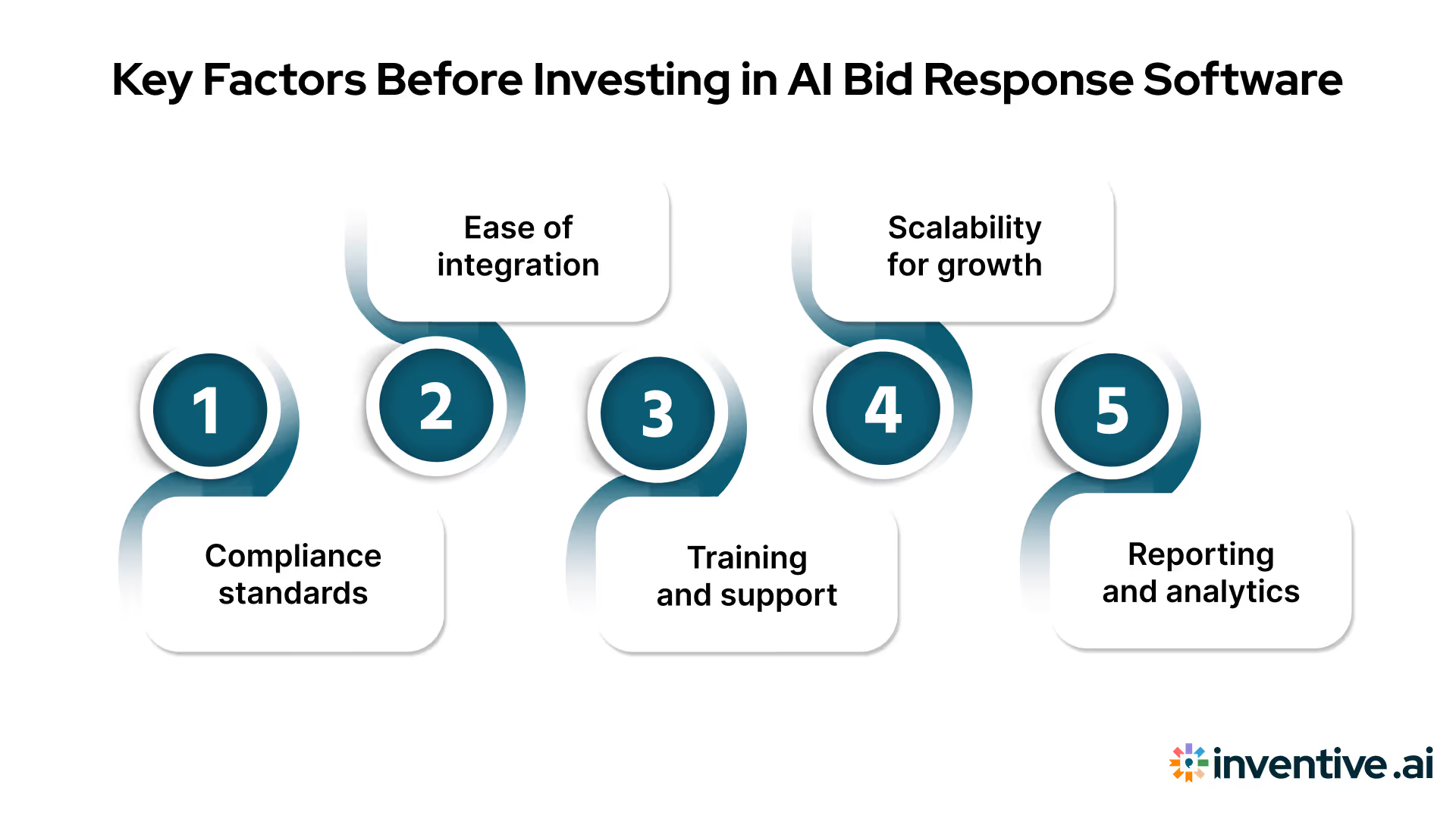AI Bid Response Checklist Software: Save Time & Win More
Learn how AI bid response checklist software automates tedious tasks, ensures 100% compliance, and helps your team win more proposals. Your guide to efficiency.

Is your bid response process slowing you down and leading to missed opportunities?
Time and accuracy are essential in winning bids, yet traditional responses often drain resources, involve too many manual steps, and create huddles.
With the turnaround time for most RFPs being 3-5 days, teams spend an average of 25 hours on a single RFP response, but inefficiencies remain a major barrier to success. Every extra hour spent on manual editing or chasing details risks delays, errors, and weaker proposals.
AI bid response checklist software solves this challenge by automating repetitive tasks, ensuring accuracy, and allowing teams to focus on strategy instead of admin work. With faster turnaround and more reliable content, organizations can compete effectively in high-pressure bidding environments.
In this guide, you will learn how AI bid response checklist software saves time, reduces errors, and strengthens overall bid quality.
Key Takeaways
- AI bid response software accelerates proposal creation, reducing manual effort and errors.
- Standardized templates ensure consistent quality and professional presentation across bids.
- Automated compliance checks minimize regulatory risks and improve proposal accuracy.
- Real-time collaboration and intelligent content reuse simplify team workflows.
- Data-driven insights enhance decision-making and increase bid win probability.
What Is AI Bid Response Checklist Software?
AI bid response checklist software is an advanced tool that uses artificial intelligence to automate and structure the entire bid response process. It helps teams build accurate, well-organized proposals without the heavy manual effort typically required.
Its core functions include content reuse, automated compliance checks, workflow management, and team collaboration. By drawing from approved content libraries and running instant validations, it ensures responses meet requirements while maintaining consistency across submissions.
The biggest value lies in time savings and accuracy. Hours of manual work shrink to minutes, giving teams the ability to focus on strategy instead of formatting. For example, a proposal that once took weeks can now be drafted in hours with far fewer errors.
This efficiency boosts productivity and raises win potential. With this understanding, now let’s see how the AI software compares with traditional bid responses.
Why Is AI Bid Response Checklist Software Better Than Traditional Bid Responses?

Traditional bid responses often demand weeks of manual effort, leaving room for errors, delays, and missed deadlines. Teams spend more time formatting and chasing compliance than actually focusing on persuasive content.
AI bid response checklist software changes this by automating repetitive work, ensuring accuracy, and creating room for strategy. Organizations using an AI RFP tool usually submit 34 additional responses each year.
Here’s why it offers clear advantages over manual methods:
1. Accuracy through automation
Manual entries often lead to overlooked requirements or mismatched details. AI-driven tools run predictive compliance checks and auto-validate responses. It reduces errors and ensures each submission meets the buyer’s expectations without last-minute fixes. The outcome is reliable, compliant proposals that improve the chances of progressing to the evaluation stage.
2. Time savings with structured workflows
Traditional bid writing can take weeks, with endless revisions and formatting delays. AI software applies structured templates and automated workflows, turning first drafts around in hours. This time saved allows teams to invest in tailoring responses to the buyer’s needs instead of managing repetitive edits.
3. Consistency in quality
Manual processes often result in inconsistent formatting, language, or tone, which weakens credibility. AI eliminates these gaps by reusing approved content and enforcing standardized formats. Buyers see polished, professional proposals every time, strengthening trust and creating a consistent brand impression across multiple submissions.
4. Higher ROI through efficiency
Human-driven responses require large resource investments and often return limited outcomes. AI systems cut down on labor hours while raising win probability with better-quality responses. This balance creates stronger ROI for businesses, where reduced costs and improved bid performance align directly with growth goals.
5. Stronger buyer perception
Buyers value proposals that are clear, fast, and accurate. Manual methods can appear rushed or incomplete under tight deadlines. AI tools deliver polished, well-structured responses quickly, showing buyers a vendor that respects their timeline and demonstrates professionalism from the very first submission.
By replacing inefficiencies with structured, AI-powered workflows, teams achieve speed and reliability. Next, you will learn how utilizing an AI bid response checklist software can improve bid management efficiency.
The 7-Step Checklist for a Winning AI-Powered Bid Response
To maximize your success in bidding, follow a structured, AI-driven approach that integrates intelligent automation with expert input. Here is a step-by-step checklist to help your team produce fast, accurate, and compelling responses while utilizing AI at every vital phase.
1. Ingest and Analyze the RFP with AI
AI scans the RFP document to extract key requirements, deadlines, and criteria. This rapid analysis identifies mandatory elements and potential risks, providing a clear roadmap for the response. Early insights improve focus and reduce overlooked details, setting a strong foundation.
2. Populate the First Draft from Your Centralized Knowledge Hub
The AI pulls relevant approved content from your centralized repository to create an initial draft. This vastly speeds up preparation while ensuring consistency and compliance by reusing high-quality, vetted responses tailored to the RFP’s context.
3. Identify and Assign Gaps to Subject Matter Experts
The system flags unanswered questions and content gaps, automatically assigning them to appropriate subject matter experts. This collaboration ensures every response benefits from specialized knowledge, increasing accuracy and persuasive power.
4. Use AI for Competitor Analysis and Win Theme Generation
AI tools analyze competitor strengths and weaknesses and help craft winning themes customized to client priorities. This data-driven insight guides positioning and messaging strategies, elevating the competitiveness of your bid.
5. Review and Personalize AI-Generated Content
Subject matter experts and editors review the AI draft, personalizing language and tone to align with brand voice and client expectations. This human touch enhances readability and relevance, converting generic text into persuasive proposals.
6. Run a Final AI-Powered Compliance and Quality Check
The platform runs automated compliance checks against regulatory and bid-specific requirements, catching errors and inconsistencies. Quality controls verify formatting, completeness, and alignment with instructions to ensure submission-ready accuracy.
7. Analyze Performance and Update the Knowledge Hub
Post-submission analytics identify strengths and weaknesses based on win/loss data. Lessons learned feed back into the knowledge hub, keeping content fresh and continuously improving future bid responses.
By following these key steps, your team will establish a disciplined, efficient process to channel AI’s full potential. Next, let’s discuss best practices to implement AI bid response checklist software for optimal results.
Best Practices to Implement AI Bid Response Checklist Software

AI bid response checklist software delivers real value only when implemented with the right approach. Many teams adopt the technology but struggle to maximize its potential due to poor setup or lack of alignment. Effective use requires planning, training, and a focus on integrating the tool with existing workflows.
Here are key practices that ensure smoother adoption and faster results:
- Start with clear goals
Define what success looks like before introducing the tool. For some teams, the goal may be cutting bid preparation time by 50%, while for others it may be raising response accuracy. Clear benchmarks help measure results and keep the rollout focused on real business needs instead of vague expectations.
- Build a centralized content library
AI performs best when it has access to standardized, approved content. Create a central repository of case studies, compliance answers, and standard responses. It ensures the system reuses high-quality content consistently. Teams save time searching for past materials and reduce duplication in responses.
Must read our guide on How AI Transforms Proposal and Bid Writing
- Train your team thoroughly
Even the best AI tools fall short without user adoption. Conduct structured training to show staff how to use features like compliance checks, template creation, and auto-suggestions. Real-life practice sessions build confidence and reduce resistance. A trained team maximizes efficiency from day one.
- Integrate with existing workflows
Isolated tools add more friction instead of solving problems. Integrate the software with document management systems, project trackers, or CRM platforms. It reduces manual handovers and ensures bid data flows smoothly across departments. For example, linking with CRM data helps personalize responses with accurate client details.
- Review and refine regularly
AI tools improve when continuously updated with feedback. Schedule regular reviews to assess performance against goals, update outdated content, and refine workflows. A quarterly check-in can identify obstructions and adjust practices, ensuring the system evolves alongside business priorities and changing bid requirements.
With these practices, organizations set themselves up for faster, more reliable bidding outcomes. However, implementation often comes with common mistakes that can limit success if not addressed early.
Common Mistakes to Avoid When Using AI Tools

AI bid response checklist software can transform how teams prepare proposals, but misuse often limits its benefits. Many organizations adopt the tool without a clear plan or misuse its features, leading to inefficiencies instead of improvements. Awareness of common mistakes helps teams avoid wasted effort and ensures better outcomes.
Here are the pitfalls to avoid and how to address them:
- Relying only on automation
While AI speeds up drafting, overdependence leads to generic responses. Buyers quickly spot templated answers that lack depth. Teams should always review and personalize outputs with project-specific details. The goal is to balance automation with human input, ensuring responses stay accurate, relevant, and engaging.
- Neglecting content updates
Outdated case studies, compliance language, or technical details weaken proposals. If the content library is not refreshed regularly, AI will recycle poor or inaccurate material. Teams should schedule reviews of stored content, replacing obsolete data with updated, approved information. A clean library keeps responses sharp and reliable.
- Skipping user training
Tools are often rolled out without proper onboarding. Untrained staff either underuse features or misuse them, slowing progress. Structured training sessions, paired with real-world practice, build confidence and help users exploit advanced features like auto-suggestions and compliance checks. Well-trained staff ensure faster adoption and consistent results.
- Ignoring integration opportunities
Many teams use AI tools in isolation, which creates new constraints. Without integration into CRMs, project trackers, or document systems, valuable data remains fragmented. Linking systems allow smooth information flow and eliminates manual copying. Integrated workflows ensure the software complements daily operations rather than complicating them.
- Failing to measure performance
Without tracking outcomes, it’s impossible to judge the tool’s impact. Teams often skip metrics like response time saved, accuracy improvements, or bid win rate. Establishing clear KPIs and reviewing them regularly ensures the software delivers measurable business value and highlights where refinements are needed.
Must Read: Comprehensive RFP Checklist for Winning Proposals
Avoiding these mistakes ensures AI tools remain an asset rather than a burden. Now, let’s discuss the features that you must consider before investing in a bid response software.
Key Features of AI Bid Response Software
Choosing the right AI bid response software starts with understanding the essential features that drive efficiency and accuracy. These core capabilities simplify your response process, reduce manual effort, and enhance collaboration, finding the way for winning more bids.
Here are a few essential features that make these platforms stand out.
- Centralized Knowledge Library
A centralized library consolidates all bid-related content and past responses into a single repository. This central hub ensures quick access to approved, up-to-date information, eliminating duplicated efforts and enabling faster, more consistent responses across teams.
- Intelligent Content Suggestions
Advanced AI engines scan the bid documents and provide smart content suggestions customized to the questions. This capability speeds up drafting by recommending relevant answers from your knowledge base and flagging outdated or inconsistent material to maintain quality.
- Collaboration and Workflow Automation
These platforms support multi-user collaboration with real-time editing, commenting, and task management. Automated workflows route tasks, assign responsibilities, and trigger reminders to ensure team alignment and smooth progression throughout the bid lifecycle.
- Integration with CRM and Cloud Storage
Smooth integration with CRM systems, Microsoft Office, Google Workspace, and cloud storage platforms centralizes data flow and minimizes errors. This connectivity lets users work within familiar environments, increasing productivity and reducing training needs.
- Reporting and Performance Analytics
Powerful analytics dashboards provide insights on win rates, response times, and compliance accuracy. Leaders can monitor bid performance, identify improvement areas, and make strategic decisions using detailed reports and audit trails.
With these features as a foundation, businesses can now evaluate the key factors to consider before investing in AI bid response software to ensure the best fit for their growing needs.
Factors to Consider Before Investing in AI Bid Response Checklist Software

Selecting the right AI bid response checklist software requires more than comparing features. With RFPs accounting for 35% of annual revenue in North America and an average advancement rate of 55%, choosing the right tool directly affects growth. Decisions should align with security needs, workflow integration, and long-term scalability.
Here are the most important factors to consider before making an investment:
- Compliance and security standards
Sensitive bid data must remain protected. Look for solutions that meet ISO, SOC 2, or GDPR standards. Strong compliance frameworks ensure data security and build trust with potential buyers. Without it, teams risk exposure to legal issues and reputational harm, especially during cross-border or government bids.
- Ease of integration
A solution that cannot connect with Microsoft Office, Google Workspace, or CRM platforms creates drawbacks. Easy integration ensures smoother workflows by centralizing information, reducing manual work, and preventing errors from duplicate entries. Smooth compatibility allows teams to manage bids within their existing systems, saving time and effort.
- Training and support
Even the best tool underperforms without strong onboarding. Ensure providers offer structured training, self-service resources, and responsive support teams. Service level agreements (SLAs) guarantee timely help during critical bid cycles. Reliable support keeps adoption high and reduces disruption, especially when deadlines are tight and errors are costly.
Must Read: Tender Writing Examples and Tips for Success
- Scalability for growth
As teams expand and bids become more global, the software must scale without performance loss. Scalable solutions allow more users, larger content libraries, and advanced collaboration features. This flexibility supports long-term growth and avoids costly upgrades or replacements as bidding requirements increase in size and complexity.
- Reporting and analytics
Leadership teams need visibility into performance metrics, including win rates, response times, and compliance accuracy. Detailed reporting provides insights for decision-making, while audit trails improve accountability. Analytics transform bid management from a reactive task into a strategic process, helping teams identify patterns and refine future responses.
Considering these factors ensures the software supports current needs and future goals. The discussion now moves to how inventive AI capabilities are reshaping bid response strategies altogether.
How Inventive AI Powers Bid Response Efficiency?
Inventive AI equips teams with advanced AI tools that accelerate and refine bid response processes. As a leading AI-powered RFP automation and SaaS management platform, it automates repetitive tasks, generates faster drafts, and simplifies content management.
Designed for industries where RFPs drive procurement: technology, healthcare, finance, and government contracting, Inventive AI ensures precision, speed, and collaboration at scale.
RFP writers often raise queries about how Inventive AI can help with win rates. Here are a few features that we bring to the table:
- 10X Faster Drafts With Highly Accurate Responses
Inventive AI’s proprietary AI solutions deliver first drafts up to 10 times faster. Responses are grounded in your knowledge sources, reducing errors and saving countless hours of manual work. Teams can then collaborate to refine the drafts, which speeds up turnaround while improving quality and consistency across proposals.
- Single Hub for All Knowledge Sources
Instead of chasing information across disconnected systems, the platform provides a centralized hub. Teams can upload past RFPs, integrate with Google Drive, SharePoint, or internal databases, and even pull Q&A from spreadsheets or websites. It ensures quick access to reliable information and eliminates the risk of missing key data.
- Fight Stale Content With AI Content Manager
Outdated information often weakens proposals. Inventive AI's content manager detects conflicting or obsolete material, ensuring only relevant, updated knowledge is used. This proactive filtering keeps responses fresh and credible, which directly improves the likelihood of impressing evaluators and advancing through competitive bidding stages.
- Higher Productivity & Competitive Advantage
Inventive AI’s AI RFP agents enhance productivity by supporting research, competitor analysis, and idea generation. These agents act as an extended team, giving organizations the ability to work smarter, respond faster, and outperform competitors in high-stakes bids without increasing headcount or overloading existing staff.
- Win Themes – The Differentiator
Unlike traditional RFP software, we introduce “Win Themes.” These automatically identify gaps in responses and pull missing information from communication platforms like Slack, emails, and calls. By personalizing content to client expectations, Win Themes improves win probability and ensures proposals consistently resonate with evaluators.
Together, these capabilities transform bid management from a repetitive task into a strategic advantage, helping organizations respond faster, with greater accuracy, and higher success rates.
Conclusion
AI bid response checklist software transforms the way organizations handle RFPs by saving valuable time. Faster responses free teams to focus on strategy, client engagement, and proposal quality. Along with efficiency, it also drives better collaboration, higher accuracy, and improved success rates in competitive bidding processes.
Creating a structured implementation plan and following best practices ensures smooth adoption. From consolidating knowledge sources to training staff, each step maximizes value. The benefits include simplified workflows, quicker approvals, reduced errors, and stronger proposals that reflect compliance and client needs.
While the software delivers significant advantages, success depends on avoiding common mistakes and carefully evaluating factors such as compliance, scalability, and integration. Addressing these challenges early helps organizations build resilience, improve decision-making, and create a future-ready bid management framework that consistently delivers results.
Frequently Asked Questions
1. How does AI improve bid accuracy?
AI improves bid accuracy by pulling responses directly from verified knowledge sources and past submissions. It reduces human errors, ensures compliance with requirements, and maintains consistency in formatting. With predictive suggestions and automated quality checks, AI helps teams deliver precise, well-structured, and client-focused responses every time.
2. Can small businesses use AI bid response software?
Yes, small businesses can benefit significantly from AI bid response tools. These platforms reduce manual work, cut response times, and help smaller teams compete with larger firms. Affordable subscription models make advanced features accessible, enabling small companies to submit polished, compliant proposals without requiring large-scale resources.
3. What industries benefit the most from AI-driven bid tools?
Industries heavily dependent on RFPs and tenders gain the most: technology, healthcare, finance, construction, and government contracting. These sectors require detailed compliance, fast turnaround, and high-quality documentation. AI-driven bid tools streamline content management, ensure precision, and enhance competitiveness, giving teams in such industries a measurable advantage in winning contracts.
4. How secure is the AI bid response checklist software?
AI bid response software follows strict compliance and security protocols such as ISO and GDPR standards. Data encryption, role-based access, and secure cloud hosting safeguard sensitive information. Vendors also provide audit trails and monitoring, ensuring confidentiality and reducing risks when handling proprietary documents or client-specific project requirements.
5. What ROI can companies expect from using AI in bid management?
Companies typically see faster turnaround, reduced manual effort, and higher win rates. AI saves labor hours, improves proposal quality, and improves efficiency, translating into measurable cost savings. With platforms like Inventive AI reporting up to a 50% increase in successful bids, the return on investment becomes immediate and long-term.


